Vehicle registration plates of Italy
Present Italian car number plates have black characters on a rectangular white background, with small blue side-fields (see European vehicle registration plates). The current numbering scheme, in use from 1994, is unrelated to the geographical provenance of the car. By law, Italian plates can only be made by the Istituto Poligrafico e Zecca dello Stato[1] and issued by local departments of motor vehicles.

History
1897-1901
The very first Italian plates had to have the owner's name and the local communal number visible.
1901-1905
These early Italian number plates gave the unabbreviated name of the place of origin, followed by a number, as GENOVA 83 and PADOVA 2. These were first plates to be made of metal and had to be manufactured by the car's owner. Today, only two plates of this time remain, GENOVA 83 and PADOVA 2, conserved in museums.
Schematic representation:
| GENOVA 83 |
1905-1927
Plates in this period were black-on-white. The registration number was a numeric code (in red), different for each province, and a progressive number on a single line, unique for that province (in black). E.g. 63 – 2993, where 63 is the code for Turin. Motorcycles had square plates.
A front plate was optional.
Schematic representation:
| 63 – 2993 |
1927-1976
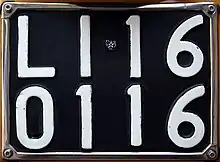
In 1927, Mussolini changed the number plates from white background with black digits, to black background with white digits and introduced the two letter provincial code for all provinces (except for Rome that was allowed to have the full name on the number plate) instead of the number system used until 1927.
From 1927 to 1932, the progressive code was found before the provincial code on a single line. Then, the progressive code was moved before the provincial code in front plates and after it in rear plates.[2] Although Rome had the full name displayed on the number plates, in documents for practical purposes it uses the unofficial code RM.
From 1932 to 1951, rear plates were squares 32.0 x 20.0 cm large and used a slightly altered Garamond font. Rear plates had the Fasces emblem next to the provincial from 1928 to 1944. After Mussolini's fall, from 1944 to 1948, the Association of War Maimed and Disabled printed the number plates and their symbol appeared instead of the Fasces. In 1948 the Constitution of the Italian Republic was approved, so the Republic emblem appeared on the number plate on both rear and front plates but the format and font were kept from the previous period.

From 1951 to 1976, rear plates size was reduced to a square 27.5 × 20 cm large, and front plates was 26.2 × 5.7 cm, the front plates' design was also changed to have more linear characters and the Republic emblem was made smaller. Note that single line rear registration plates (similar to the ones used by other European countries) were not available until 1976. The registration number was the provincial code, which is a two-letter code (exception: Rome's code is Roma), and a progressive code, unique for that province, up to 6 characters long. Between the provincial code and the first two digits was the Italian Republic emblem (a garland surrounding a five-pointed star with the letters "RI" in the middle of the star).
The progressive code for the first 999999 cars of the provinces was just a progressive number, not filled with initial zeroes; in the rear plate the last four digits were in the second row and the first ones (when present) in the first row. For cars from 1000000, it was A00000-A99999, B00000-B99999 etc. Possible letters were, in this order, A B D E F G H K L M N P R S T U V Z X Y W. After that, it was 00000A-99999A, 00000D-99999D etc. Possible letters were, in this order, A D E F G H L M N P R S T V W X Y Z; then, the letter was moved to the second position, and then to third (same range as in second position).
Schematic representation:
| LI 16 0116 |
Front Plate
| 160116 LI |
1927-1932 rear plate
| 10122 ROMA |
1976-1985

The front plate was kept intact as in the 1927-1976 period. The rear plate, instead, began to be manufactured in two pieces. One, sized 10,7 × 33 cm, had black background with white digits, contained the progressive number and, in a very small font, the repetition of provincial code above and the Republic emblem. The other had black background with orange letters and contained the official provincial code and had two variants. One was 10,7 × 33 cm large, the other one was 10,7 × 20 cm large. Only one of the latter two was used depending on the type of plate holder that the plate was destined for: for a rectangular plate holder, the small provincial code piece was installed left of the progressive code, put together with rivets in specifically designed holes in the progressive code For cars that were designed with the previous number plate holder (Square), or too small for a rectangular plate, the long provincial code piece was installed above the progressive code. This change resolved the plate positioning problem on cars of foreign production, eventually the rectangular European system was preferred over the squared plate holder of Italian designed cars.
Front Plate
Rear plate (Rectangular)
Rear plate (Squared)
1985-1994 1985-1994 Italian rear car number plate. VR is the provincial code of Verona. In 1985, plates began to use black digits on white reflective background. Rear plates remained identical as in the 1976-1985 period. Front plates became larger (32.5 × 10.7 cm) but remained slightly smaller than rear plates. The progressive code was moved after the provincial code, as it was already for rear plates. The reflective background had an official code that appears on the background in small letters, PGS B1 or PGS A1. (PGS means "Provveditorato Generale dello Stato" and A or B is the city where the reflective was made and 1-2 means white or yellow reflective) This new system made so that provinces with less than 6 digits had to have a 0 in place of the missing digits (LC 004239). The highest combination reached with the 1927 system was MI 01D000 for the province of Milano in 28/02/1994, the same day plates using the new system started to be issued. In 1994, the provinces that were instituted in 1992 (Lecco, Verbania, Vibo-Valentia, Lodi) were allowed to choose to issue either the old 1927 system plates (PP NNNNNN) or the 1994 standard (LL NNN LL), up to 12.000 plates until 1999. Rear Plate (Rectangular)
Front Plate
Rear Plate (Square)
1994-present 1994-1999 Italian rear number plate. AE 000 HJ to AE 999 HJ belongs to the province of Como From 28 February 1994 an entirely new numeration system was introduced which omitted any explicit reference to the place of origin. A simple alpha-numeric serial code takes the form AA 999 AA. Here ‘A’ can be any letter of the Latin alphabet except I, O, Q, U and is treated as a base-22 digit; ‘9’ can be any decimal digit. e.g. AK 514 RH, AX 848 LK, BA 924 NS, etc. The three-digit number changes first, then the letters from right to left. So, first plate is AA 000 AA, followed by AA 001 AA...AA 999 AA, then AA 000 AB to AA 999 AZ, then AA 000 BA to AA 999 ZZ, then AB 000 AA to AZ 999 ZZ, then BA 000 AA to ZZ 999 ZZ. Rear plates are no more in two pieces. Instead, a square plate can be chosen instead of the ordinary long one for vehicles with a squared plate holder. If the rear plate is square, the numbering scheme starts from ZA 000 AA.  1999-present Italian vehicle number plate from Bolzano. In 1999, the plates were redesigned, starting from the serial number BB 000HH. The digits are thicker. The last decimal digit is now very close to the third letter. The standard European blue band has been added on the left side, with the European flag motif (12 yellow stars) and the country code I. Another blue band was added, on the right side, bearing a yellow circle with the year of registration (optional). The two-letter provincial code is optionally present on the right band in capital letters. For the capital city of Rome, the word Roma replaces the two-digit provincial code. Provincial codes are in capital letters except for three cases, where the second letter is expressed in small caps for the provincial codes of the autonomous provinces of Bolzano/Bozen (Bz) and Trento (Tn) and the autonomous region Aosta Valley (Ao), that are surmounted by the local coat of arms. The reintroduction of the provincial code (although no longer as a compulsory element of the plate) was implemented because the 1994 suppression of the two-letter provincial codes proved extremely unpopular. Unlike before, the provincial code is not part of the registration number, which is the same for the whole nation. Despite an initial period of popularity, the right band remains empty in most cases. Since 2003 the PGS B1 or PGS A1 code has been replaced by the code MEF B1 or MEF A1
1994-1998 Squared rear number plate
Special platesMotorcycle plates1994 standard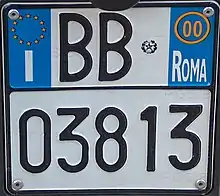 Motorbike number plate from Rome Motorcycles from 1999 have plates with two letters and five digits, starting from AA 00000. For these vehicles, the province codes are not used to avoid confusion (i.e. the plate after AF 99999 is AH 00000, because AG is the old provincial code for Agrigento). Plate size is 177 mm × 177 mm (7 in × 7 in). Like cars, motorcycles have blue two lateral bands, on the left is the EU band with the circle of 12 stars and Italy's international code (I) . On the right, the blue band has a yellow circle with the year of matriculation (00=2000) and underneath, the optional provincial code sticker (Roma= Rome). From 1994 to 1999, motorcycles didn't have the blue bands, and the first digit was on the right of the first two letters. Due of the large quantity of old provincial system plates, the 1994 system motorcycles plates started to be distributed from 1996.
1994-1999 Motorcycle standard
Former provincial code system (1927-1994)From 1927 until 1994 motorcycles, like cars, used to have the Provincial Code instead of the two letters on two lines, followed by a maximum of 6 digits From 1927 to 1932, Motorcycles used to have white digits on a black background and the provincial code was after the digits on the second line, in 1932 (to 1985) the motorcycle plates changed to a white background with blue digits, the provincial code was moved before the digits and like cars, Motorcycles used the Garamond font until 1951. In 1951 motorcycles, unlike cars, had a font transition that was completed in 1963, when plates started to be made of plastic but keeping the old format. From 1985 to 1994, motorcycles changed to a white reflective background and black digits and returned to be made of metal Example of 1932-1985 Motorcycle plate from the province of Milano
1927-1932 Motorcycle plate
1985-1994 Motorcycle plate
Moped plates 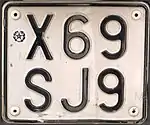 Old (left) and new (right) moped plates Registration plates of small mopeds were introduced in 1994; before that date Italian mopeds had no plate at all. They were trapezoid-shaped and had a registration system based on a five letter-and-digit combination (treated as a 31-base numeric system), with the first two placed on top and the following three below (such as 47 A23 or K3 561 or 8X 4RF, whereby whole sets of series were assigned locally). In 2006 new moped plates were introduced; new plates have a rectangular shape measuring 12 by 14 cm. The registration shows six characters: the first is always "X" ("Y" for Local Police plates), the other five follows the same scheme as the old system; however the digit 1 and 0 and the letters A, E, I, O, Q and U are not used. Since 2012 old moped plates are no longer valid and have to be replaced by new ones. The reason for the change was that with the old moped system, the plate could be transferred to another moped and was bound to the owner rather than the vehicle, whereas the new plates are bound to the vehicle. Trailer plates Trailer plate until 2013 Car and truck trailers had two plates: the trailer's own one was quite small and bore the word "RIMORCHIO" (trailer) and a two letters-five digit code, the other had the same size of vehicles' rear plates and bore the same registration of the prime mover with black decal-characters on a retroflective yellow base. From February 2013 new trailer plates were introduced: they use the same pattern of standard vehicle plates, the numeric scheme is XL 000 LL where "L" is a generic letter, "0" is a digit and "X" is the reserved letter. Mover repetition plates are no longer needed on trailers registered with new plates, however they are still compulsory for old trailers with small plates and small unregistered "appendix trailers". From 1932 to 1959 trailer plates were the same as car plates (white digits on a black background), only with the word "RIMORCHIO" under the numbers, written in italic. After 1959 to 1985, the trailer plates were like the front vehicles number plates (black background with white digits), with the digits before the provincial code, with the word "RIMORCHIO" above the digits followed by the provincial code. From 1985 until 1994 the trailer plates were enlarged, had black digits on a white reflective background with the provincial code before the digits and the word "RIMORCHIO" assumed red coloration. Until 1993 they had to be displayed on the right of the trailer. Trailer plate Schematic representation (2013): 1994-2013 Trailer plate
1985-1994 Trailer plate
1959-1985 Trailer plate
1932-1959 Trailer plate
Police plates Registration Plate of Polizia Nazionale  Registration Plate of Guardia di Finanza Local police forces have the word "POLIZIA LOCALE" (local police) in blue. They have the same pattern as trailer and civilian plates, the scheme is YL 000 LL where "L" is a letter, "0" is a digit and the "Y" is the reserved letter (for motorcycles YL 00000, mopeds Y00 000). Unlike civilian plates they don't show up the code. National police plates have "POLIZIA" in red followed by letter, then numbers (formerly numbers only until 1983). Customs police plates start with prefix "GdiF" in red. The serial letters and three serial numbers are in black.[3] Pre-1983 National Police rear plate
Pre-1983 Front National Police plate
Current National Police plate
Current Guardia di Finanza (Customs) plate
Local Police Plates (From 2009) Diplomatic plates Current Registration Plate of Corpo Diplomatico from Vatican City (XG) since 1995
From 1932 to 1951 the diplomatic plates are square 32.0 x 22.0 cm, white digits on a black background using the Garamond font with the "CD" prefix instead of the province followed by a max of 5 digits, the first two digits was the country's code. From 1951 to 1976 the diplomatic plates are square 27.5 x 20.0 cm, white digits on black background, changed to a more linear font, but the system was identical from the previous period. ex: CD 22843 From 1976 to 1985 the diplomatic plates are on a single line, black background with white digits, with the letters "CD" vertically aligned, followed by 5 digits, the first two represented the country, the other three a progressive number. In 1985 to 1995 the diplomatic plates have white reflective background with black digits, with blue letters and change to a CD 000 AA system, with the letters representing the country. The Italian Republic emblem appears on top of the first two letters of the plate and on the top right the international white oval with a black letter representing Italy's international code (I) Registration Plate of Nazioni Unite (Specialists) Diplomatic plates have blue letters since 1985 and have 4 numbers to avoid confusion with the new civilian plates issued since 1994. These have the "CC" (Corpo Consolare), "CD" (Corpo Diplomatico) and four numbers, while "UN" (Nazioni Unite (Permanent)), "UNP" (Nazioni Unite (Specialists)), and "UNT" (Nazioni Unite (Transit)) plates have three. Scheme is CC 0000 AA or UNP 000 AA. The "AA" is a country code (blue) while "0" is a digit. Front and rear plates are identical and both measure 34 by 11 cm. There are no diplomatic motorcycle plates used.
Military plates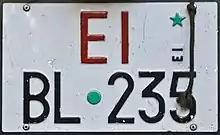 Registration Plate of Esercito Italiano  Registration Plate of Marina Militare Military plates have the prefixes EI (Esercito Italiano, Army), AM (Aeronautica Militare, Air Force) and MM (Marina Militare, Navy), all of them red, the trailers have the indication "RIMORCHIO". There is a code same as mentioned before, but it is small and it is black. The scheme is EI LL 000. While "EI" is the prefix, "LL" is a letter and "0" is a digit to prevent confusion with civilian plates issued from 1994. Between the letter and number there is a green dot. In 1980 Army plates adopted the 11 by 34 cm size for both front and rear plates, but more recent plates use the 1994-99 civilian plate standard for rear plates. Starting from 2004, historical military vehicles that no longer possess the original plate use instead the scheme EI VS 000, "VS" is colored green. Until 1995 army plates used an EI 000 AA system and before 1985 used an EI 000000 system with the same dimension of civilian plates (smaller front plate) where certain number ranges were reserved for types of vehicles EX: EI 900000 to EI 999999 were reserved to trailers and EI 400000 to 450000 were reserved for recon vehicles. However, the pre-1979 numbers only system is still used for armored vehicles and tanks.
Current Army motorcycle plate
Current Army motorcycle plate
Current Army Trailer plates
1979-1995 Army Trailer plates
Pre-1979 Army Trailer plates
Red Cross plates Registration Plate of Croce Rossa Italiana Have the prefix "CRI" (Croce Rossa Italiana) in red, the style is CRI 000LL (pre-2007 was CRI L000L, motorcycles CRI 00000), while "L" is a letter, and "0" is a number on a white reflective background. Between "CRI" and the other characters there is the Red Cross sign. They use the same style of pre-1999 plates; the final code of two-line plates always starts with the letter "Z". Trailer plates have the word "RIMORCHIO" above the digits using a CRI 0000 system. Before 1985 Red Cross plates had a dot after every number and had the same format of civilian plates (smaller front plate) Until 1985 Red Cross plates were numbers only, after late Seventies ambulances had to have the L000L format, while service cars continued to have numbers only until 2002 where all new Red Cross vehicles had to have the L000L system.
Firefighters Registration plate of Vigili del Fuoco  Registration plate of Vigili del Fuoco di Trento Before 1938 Firefighters vehicles used civilian plates Since 1938 have the prefix "VF" (Vigili del Fuoco) in red . They have the same style and dimension of Port Authority plates, but they don't have text in the bottom section. Firefighters of autonomous regions use special Firefighters plates issued locally. Their schemes were VF 0L0 AA (formerly VF L00 AA), where "AA" at the end can be TN or BZ. Trailers have small red "R" between prefix and numbers.
Port Authority platesHave the prefix "CP" (Capitaneria di Porto) in red. They have the text "GUARDIA COSTIERA" at the bottom. Those plates are considerably shorter than a standard one (circa 35 by 52mm), front and rear plates have the same size and square rear plates are not available. Schematic representation:
SMOM plates Vehicle registration plate of the Order, as seen in Rome, Italy. Uses prefix "SMOM" (Sovrano militare ordine di Malta) in red, followed by two numbers (previously red). They have the text "SMOM" at the bottom. These plates used only by Sovereign Military Order of Malta members (only plate that was circulating on along with its diplomatic plate (code XA), being SMOM is a subject of international law.), and these plates were issued by Ministry of Defence. Schematic representation:
Temporary platesThese plates are used for vehicles temporarily circulating in Italy, but have to be exported, "EE" stands for "Escursionisti Esteri" (Foreign Hikers or temporary plates). They have the same style of Diplomatic plates, but they start with "EE" (black) instead of "CD". The upper part of the plate has a small space for accommodating expiry date stickers. From 1932 to 1951 they are square 32.0 x 22.0 cm, white digits on a black background with Garamond font, using an EE 00000 system. From 1951 to 1976 they are square 27.5 x 20.0 cm, white digits on a black background with different font style and have the EE prefix instead of the province followed by a max of 5 digits ex: EE 10245 From 1976 to 1985 they are on a single line, white digits on a black background and the letters EE are vertically aligned, followed by a max of 5 digits. From 1985 they are on a single line, black digits on white reflective background with the EE 000 AA system. Motorcycles had the "EE" on the first line then 4 digits on the second line, white background with blue digits from 1932 to 1985 and have the sticker space above the republic emblem.From 1985 motorcycles have the prefix followed by a letter and a progressive number. Schematic Representation:
Temporary series from 1976 to 1985
Temporary series from 1932 to 1976
Temporary motorcycle plates from 1932 to 1985
Temporary motorcycle plates from 1985
Agricultural platesAgricultural machines have motorcycle-sized plates following the AA-0/00A scheme written in black on yellow. Agricultural trailers have the text "RIM AGR." in red on the upper part. The style is same as the old trailer plates but background is yellow and the serial is AA-000A. Agricultural trailers have to show both their own plates and a prime mover repetition one. Agricultural plates from 1994
Agricultural trailer plates from 1994
Agricultural trailer plates from 1985 to 1994
Agricultural trailer plates from 1959 to 1985
Agricultural plates from 1948 to 1985
Agricultural plates from 1985 to 1994
Repeater plate used from 1985 to 1994
Repeater plate from 1994
Road Machinery plates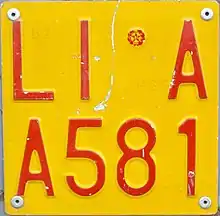 Old Registration plate of Road Machinery (1992-1994) The style of these plates is LL LNNN. They are square, red on yellow background. They were introduced in 1992, until 1994 they used a LL LLNNN System, where the first two letters were the provincial code. Due of the low road machinery plates assigned, provinces had been distributing the old system plates over the course of many years before the new ones appeared. Road Machinery plate from 1992 to 1994
Current Road machinery plate
1992-1994 Trailed Road machinery plate
Current Trailed Road machinery plate
Civil Defense plates Registration plate of Protezione Civile provinciale di Bolzano _civil_protection_license_plate.jpg.webp) Registration plate of Protezione Civile provinciale di Trento These plates only exist in autonomous regions, they have the prefix "PC" (Protezione Civile) in red and an alfanumeric serial chosen by local authorities (PC ZS0LL in Bolzano (ZS means Zivilschutz), PC L00TN in Trento). Cars of national Civil Defense department have special plates bearing the "DPC" (Dipartimento della Protezione Civile) code followed by an alphanumeric serial (DPC L 0000) in Rome, while operative vehicles usually use civil plates. Emergency plates have the text at top:"DIPARTIMENTO PROTEZIONE CIVILE RICOVERO DI EMERGENZA", then a provincial designator and four numbers.
Carabinieri plates Registration Plate of Corpo di Carabinieri These plates have the prefix "CC" (Carabinieri) in red from 2000 when the Carabinieri became an independent corp. The style is CC LL 000 where "CC" is a prefix, "LL" is a letter, and "0" is a digit. Motorcycles use a CC A0000 system. Until 2000 "CC" plates didn't exist and used the Army (EI) plates and the first CC plates (which were re-adapted EI plates) had a CC separate piece put over the first part to cover up the "EI" code Schematic representation:
Motorcycle plate
Trolleybus platesThese plates' format is the two-letter provincial code, followed by the operator's logo and number (normally 3 digits). They use white digits on a blue background, and their size is 320 x 115 mm. Until the 1950s they were circulated along with normal car plates. Test PlatesTesting plates have a square (16.5 by 16.5 cm) size and follows the format XX p X/XXXX (where "X" could be a letter or a digit ) arranged in two lines since 2003. They are the only kind of Italian plates whose code could be chosen by the owner. These plates have a "P" instead of the republic emblem that means Prova (Test) These plates are usually used from car dealers to test the cars on the public road, for cars that don't have an insurance or don't have a regular number plate available. They can be transferred on other cars From 1951 to 1976, testing plates used to be square, black background with white digits, in middle the word "PROVA" was written in red, followed by the provincial code, the official emblem and a progressive number. From 1976 to 1985, these plates used to have black background with white digits on a single line, with the provincial code followed by a progressive number and the word "PROVA" vertically aligned by 90° degrees. Until 1994, Test plates used to have the provincial code instead of the first two digits, followed by a random combination of letters and numbers. From 1994 to 2003, the plates used to be on a single line with two letters followed by the random digits. Current Prova plate
1985-1994 Prova plate
Test series from 1948 to 1976
Test series from 1976 to 1985
Province codesProvince codes 1927 to present dayThese abbreviations for the names of provinces are extensively used in contexts other than vehicle registration. For example, "Trino (VC)", to indicate a place called Trino in the province of Vercelli, could appear on letterheaded paper or in a postal address or in a guide book and very often on business cards and trade signs. The abbreviations even count as valid words in crosswords and in Scarabeo, the Italian version of the board game Scrabble. Sometimes, the code RM is used instead of Roma for the province of Rome, in postal addresses or documents. Province codes 1905 to 1927
Defunct province codes (post-1927)
StatisticsBased on the data available in the Automobile Club d'Italia's database updated to the year 2017, the 44% of the vehicles immatriculated in Italy was powered by petrol, the 47% by diesel, and only a 9% was powered by a hybrid or bi-fuelled engine alimentation. Vehicles belonging to the emission classes from Euro 0 to Euro2 had a prevalence of petroil alimentation, while diesel engines were increasingly diffused in the Euro3 and Euro4 emission classes.[4] Diplomatic codesGreyed out means not used. Bold means it's used. Q and U cannot be used in consular corps plates, as such they are Bold Italic.[5][6] | |||||||||||||||||||||||||||||||||||||||||||||||||||||||||||||||||||||||||||||||||||||||||||||||||||||||||||||||||||||||||||||||||||||||||||||||||||||||||||||||||||||||||||||||||||||||||||||||||||||||||||||||||||||||||||||||||||||||||||||||||||||||||||||||||||||||||||||||||||||||||||||||||||||||||||||||||||||||||||||||||||||||||||||||||||||||||||||||||||||||||||||||||||||||||||||
References
- http://www.ipzs.it/ext/targhe_veicoli.html
- The use of alphabetical codes for number plates started in Italy on 28 February 1927, as prescribed by the Communication n. 3361 from Minister of Public Works (from R.D.I. n.314 13.3.1927 and the law n.2730 29.12.1927) which inaugurated a new highway code.
- Italy's page on Worldlicenseplates.com
- C. Marino; C. Monterosso; A. Nucara; M. F. Panzera; M. Pietrafesa (2020). "Analysis of the Reduction of Pollutant Emissions by the Vehicle Fleet of the City of Reggio Calabria Due to the Introduction of Ecological Vehicles". Sustainability. MDPI. 7 (12): 2877. doi:10.3390/su12072877. ISSN 2071-1050. OCLC 8570761712. Archived from the original on September 4, 2020 – via DOAJ.
- "CD and CC registration plates". Retrieved 24 April 2016.
- "Diplomatic codes after 1984". Retrieved 24 April 2016.
External links
- Plates in Rome provides detailed coverage of Italian number plates from 1903 onwards.
- Italian plates With details and images
| Wikimedia Commons has media related to License plates of Italy. |